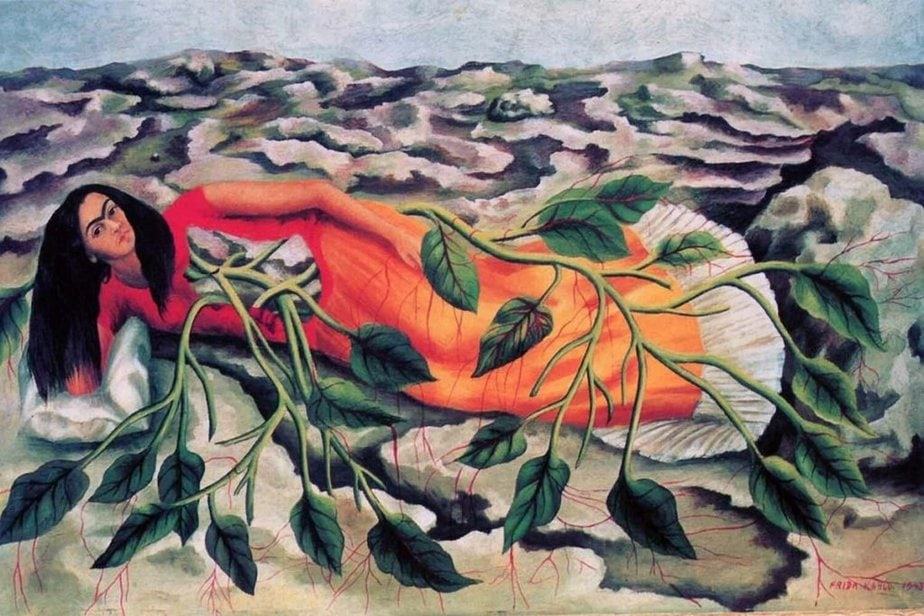Frida Kahlo lived the epitome of alegría — a lust for life.
Despite her paintings frequently being categorised as surrealism, Kahlo considered her masterpieces bizarre realities. No wonder Frida Kahlo’s paintings remain a powerful tombstone of her talent and legacy.
“They thought I was a Surrealist, but I wasn’t. I never painted dreams. I painted my own reality.”
Frida Kahlo infused her canvas with her native Mexican birthright and the historical epochs of her life. Frida Kahlo’s artistic style has been world-renowned.
The stars, the earth, and the body all mingled with her painful reality, the long-term aftermaths of the life-changing trolley accident bleed onto the abstracts of Mexican symbols and history. It was colonial and revolutionary. The abstract was all too concrete for her, as real as the prison of pain.
1.The Two Fridas(1939)
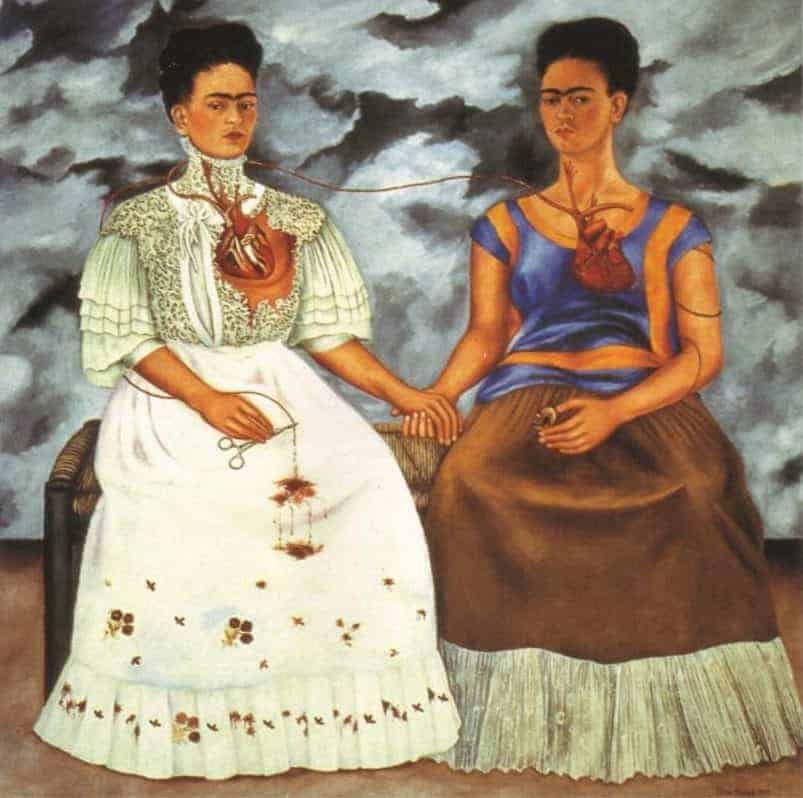
The Two Fridas Painted in 1939, this work depicts two versions of Kahlo seated together, one in traditional Mexican attire and the other in a European-style dress. The painting explores themes of identity and duality.
2.Henry Ford Hospital By Frida Kahlo(1932)

The stark contrast between the industrial backdrop and Kahlo’s vulnerable, exposed figure amplifies her feelings of isolation and alienation.
This painting powerfully conveys the intersection of bodily pain, emotional trauma, and the dehumanizing effects of industrialization, reflecting Kahlo’s ability to channel her personal grief into a universally resonant work of art.
3.Girl With Death Mask(1938)
Girl with Death Mask” by Frida Kahlo, created in 1938, is a haunting exploration of innocence and mortality. The painting features a young girl, often believed to represent Kahlo as a child, standing in a desolate, barren landscape.
The girl wears a bright pink dress, symbolizing innocence and youth, but a skull-like death mask, a symbol of mortality and the inevitability of death obscures her face.
At her feet lies a small, lifeless animal, further emphasizing the theme of death.
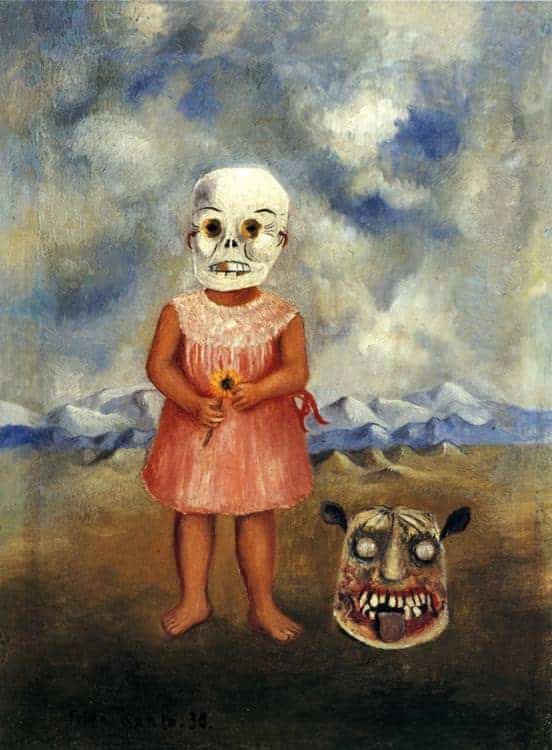
Girl with Death Mask” by Frida Kahlo, created in 1938, is a haunting exploration of innocence and mortality. The painting features a young girl, often believed to represent Kahlo as a child, standing in a desolate, barren landscape.
The girl wears a bright pink dress, symbolizing innocence and youth, but a skull-like death mask, a symbol of mortality and the inevitability of death obscures her face.
At her feet lies a small, lifeless animal, further emphasizing the theme of death.
Frida Kahlo’s original paintings are always on demand in every forms and medium. Millennial artists use the paintings of Frida Kahlo to complement their design and art products.
4.Frida And Deigo Riveria(1931)

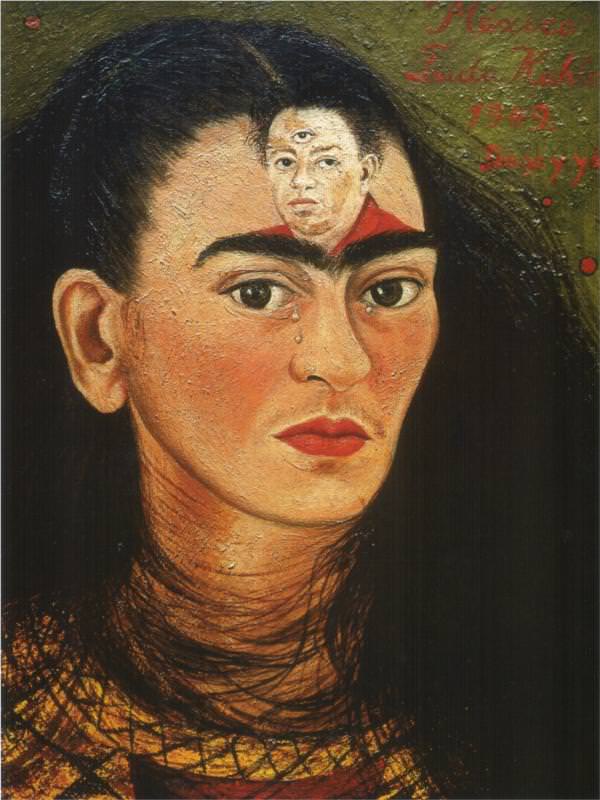
Rivera’s portrait is placed directly on Kahlo’s forehead, almost as if embedded in her mind, signifying how deeply intertwined he is with her identity and emotions.
The tears and Rivera’s presence convey the complexities of their relationship, marked by love, infidelity, and emotional turmoil.
Through this intimate and symbolic self-portrait, Kahlo reveals her vulnerability and the overwhelming impact Rivera had on her psyche.
6.Broken Column(1944)
“The Broken Column,” painted by Frida Kahlo in 1944, is a powerful representation of her physical and emotional suffering.
Kahlo depicts herself with a split torso, revealing a crumbling Ionic column in place of her spine, symbolizing the severe spinal damage she endured after a bus accident in her youth.
The column reflects her constant pain and the instability she felt within her own body.
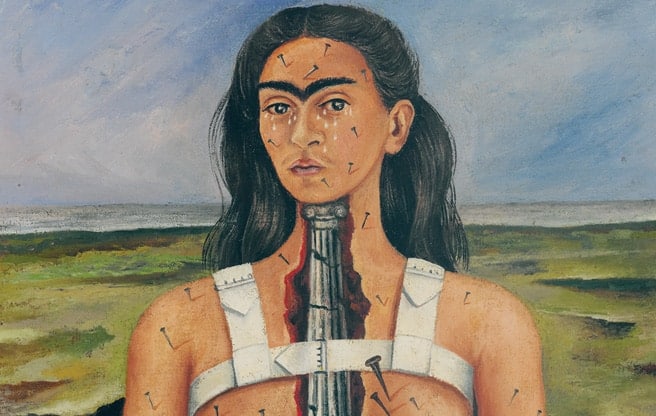
Despite the stark imagery of pain and brokenness, Kahlo’s unwavering gaze and the restraint in her expression convey her resilience and determination to endure, making “The Broken Column” a poignant exploration of suffering and strength.
7.A Few Small Nips By Frida Kahlo (1935)

This work reflects Kahlo’s own emotional pain and commentary on violence and betrayal, particularly related to her tumultuous relationship with Diego Rivera.
8.My Grandparents And My Parents And I(1936)
“My Grandparents, My Parents, and I” (“Mis Abuelos, Mis Padres y Yo”), painted by Frida Kahlo in 1936, is a family portrait that combines personal and symbolic elements.
In this painting, Kahlo depicts herself with her parents and grandparents, arranged in a familial tableau.
She is shown standing at the center, with her mother, Matilde, and her father, Guillermo, positioned beside her, while her grandparents are depicted in the background.
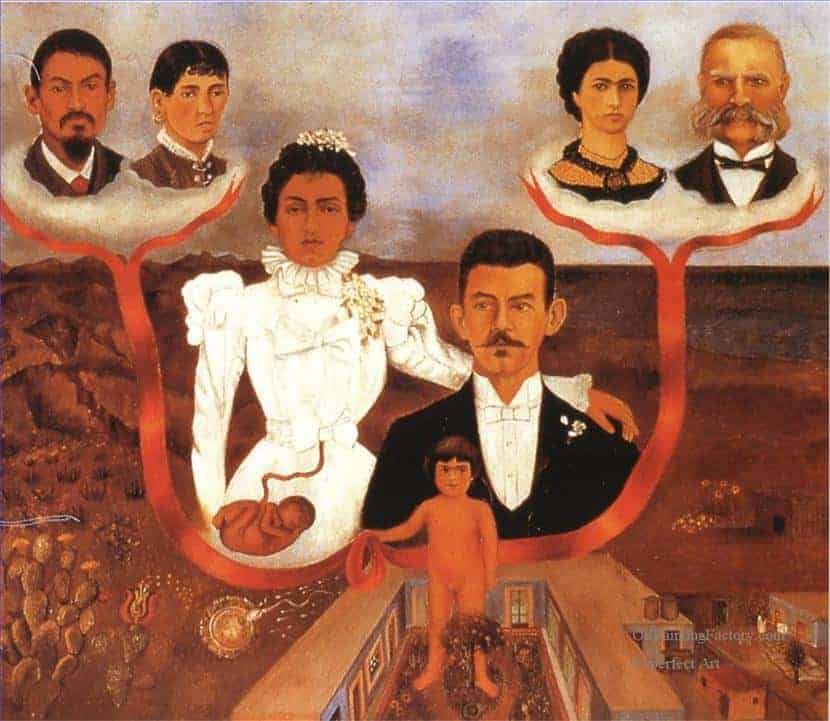
The painting is notable for its use of vivid colors and a formal composition, blending elements of traditional Mexican art with a personal narrative.
Kahlo’s depiction of her family emphasizes their importance to her identity and heritage.
The inclusion of symbolic details and the structured layout of the figures reflect her deep connection to her roots and the role her family played in shaping her life and work.
9.Frida Kahlo Painting
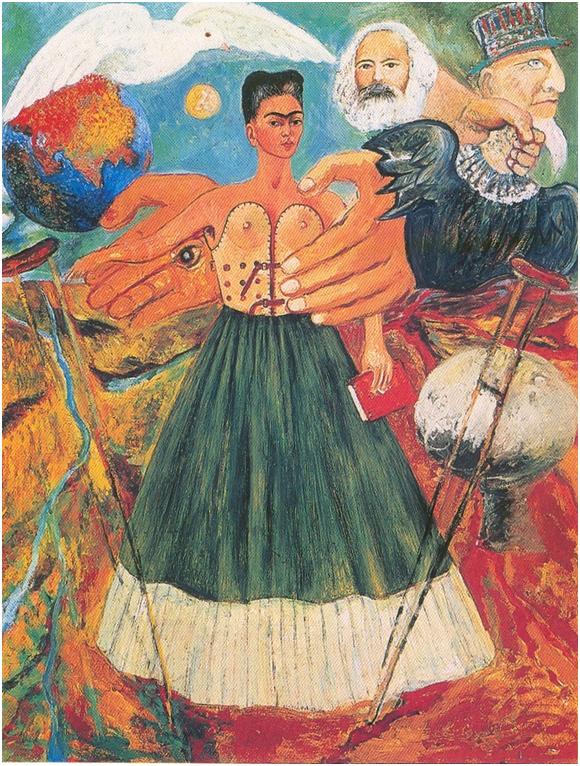
10.Self Portrait Dedicated To Leon Trotsky(1937)
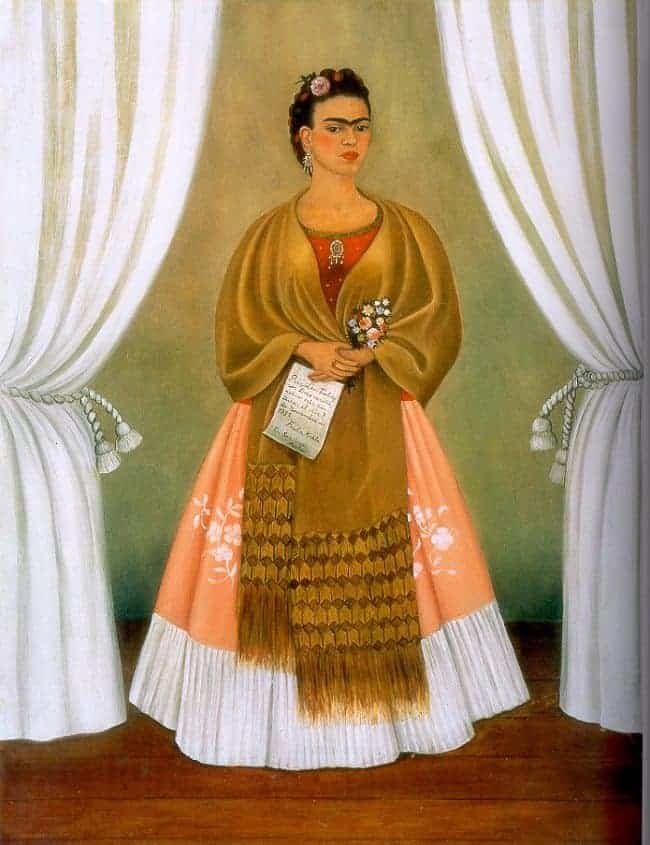
The painting includes a portrait of Leon Trotsky, the Russian revolutionary and Marxist theorist, who was living in exile in Mexico at the time. Trotsky’s image is included in the background, referencing the support and admiration Kahlo and her husband, Diego Rivera, had for Trotsky and his political ideas. The self-portrait serves both as a tribute to Trotsky and as an expression of Kahlo’s own political beliefs and artistic identity.
11.Self Portrait Velvet Dress By Frida Kahlo(1926)
“Self-Portrait in a Velvet Dress” painted by Frida Kahlo in 1926, is one of her early self-portraits that reflects both her burgeoning artistic style and her personal aesthetic. In this painting, Kahlo is depicted wearing a luxurious velvet dress with intricate details, which contrasts with the simplicity of her direct, introspective gaze.
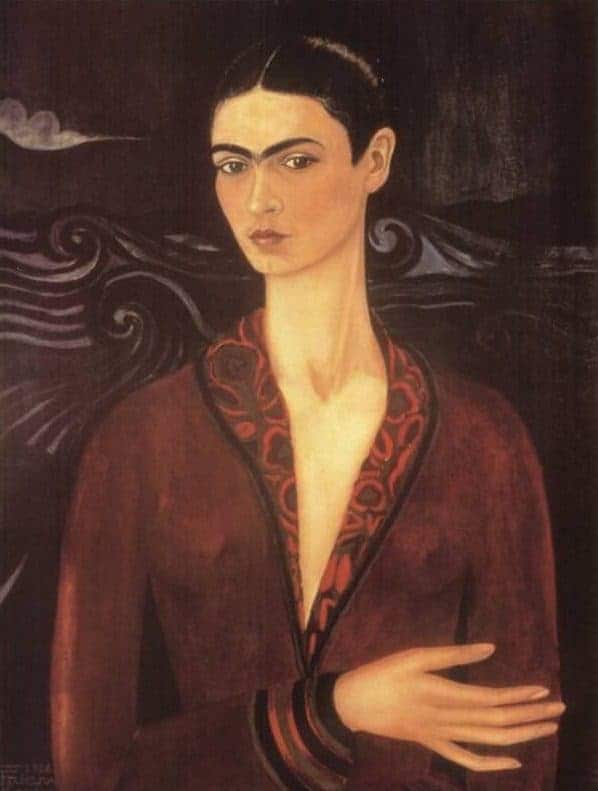
The portrait showcases Kahlo’s skill in capturing textures and patterns, and it is notable for its refined and elegant presentation.
The velvet dress emphasizes her sense of self and her desire to assert her identity, even at a young age.
This early work reveals Kahlo’s evolving style and her ability to combine personal expression with technical proficiency.
12.Self Portrait Time Flies By Frida Kahlo(1929)
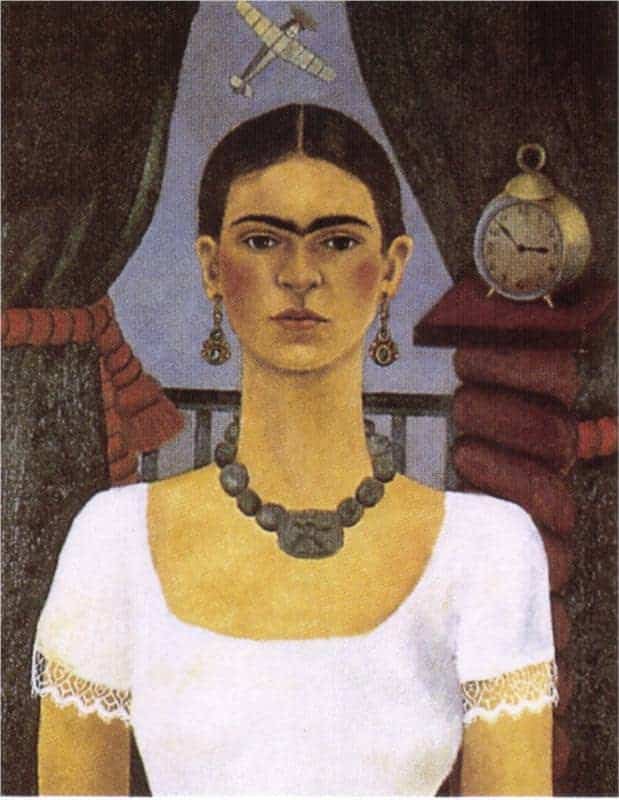

Self-Portrait with Braid” (1941) by Frida Kahlo features the artist with her hair styled in a traditional braid, symbolizing her connection to her Mexican heritage.
Dressed simply, Kahlo gazes directly at the viewer with a contemplative expression.
The vibrant background reflects her ongoing embrace of Mexican cultural motifs and her resilience despite personal struggles.
14.Self Portrait With Cropped Hair By Frida Kahlo
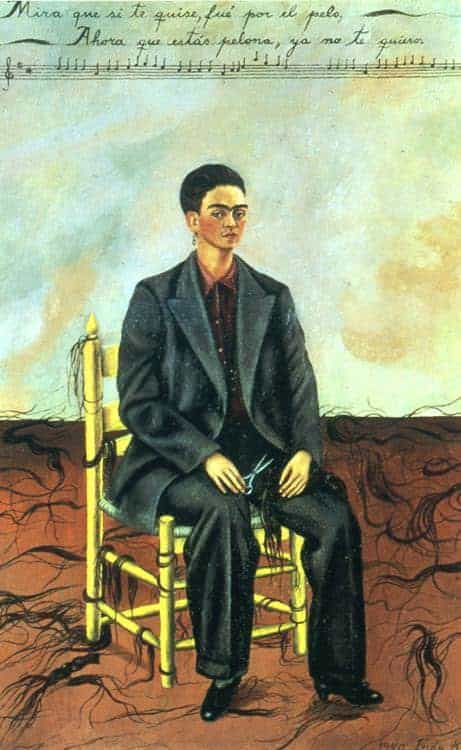
“Self-Portrait with Cropped Hair” (1940) by Frida Kahlo shows her with short hair and wearing a man’s suit, reflecting a period of personal transformation and defiance.
The backdrop of cut hair underscores the theme of liberation and Kahlo’s challenge to traditional gender norms
15.Still Life With Parrot (1941)
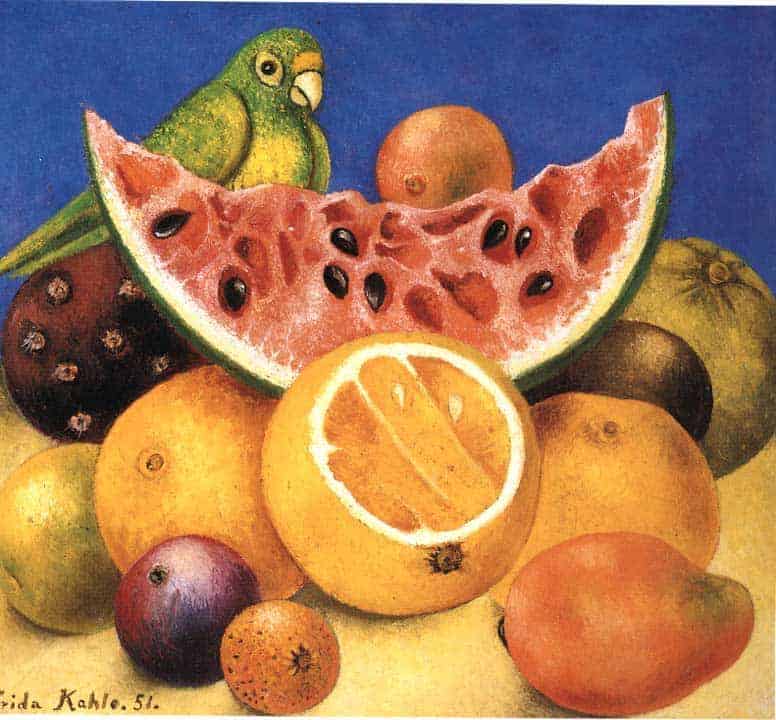
Still Life with Parrot” painted by Frida Kahlo in 1941, features a vibrant arrangement of tropical flowers and a parrot perched on a table.
The painting combines elements of traditional still life with vivid colors and exotic motifs, reflecting Kahlo’s fascination with Mexican flora and fauna.
The parrot adds a touch of life and symbolism, enhancing the composition’s richness and cultural depth.
16.Self Portrait With Monkey(1938)
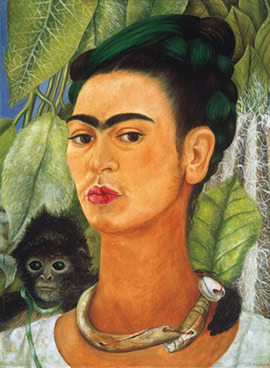
Self-Portrait with Monkey” (1938) by Frida Kahlo depicts her with a monkey on her shoulder, highlighting her connection to nature and animals.
The vibrant background and traditional Mexican attire emphasize her cultural pride and add a touch of intimacy and whimsy to the portrait.
17.The Wounded Deer(1946)
“The Wounded Deer” , painted by Frida Kahlo in 1946, portrays Kahlo as a deer with multiple arrows embedded in its body.
The image reflects her physical and emotional pain, as the deer symbolizes vulnerability and suffering. Kahlo’s face is visible on the deer’s head, conveying her personal anguish and resilience.
The painting’s vibrant colors and symbolic elements emphasize the depth of her struggles and her enduring strength.
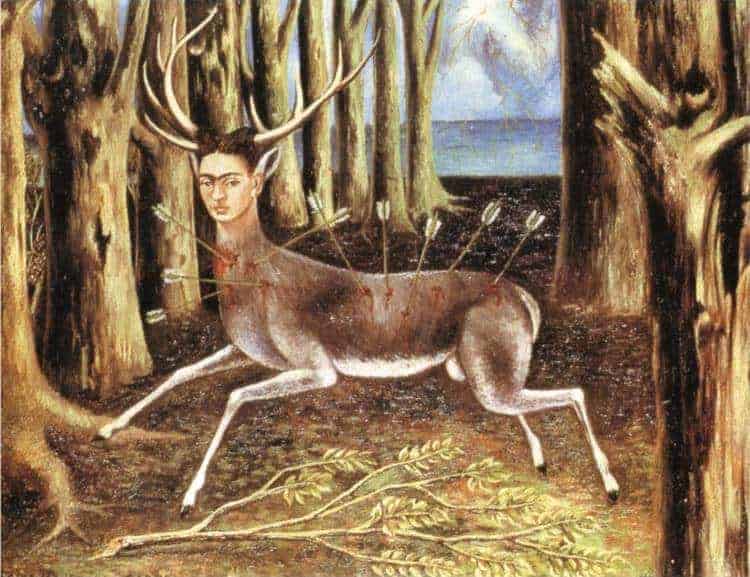
18.What I Saw In Water By Frida Kahlo(1938)
“What the Water Gave Me” (1938) by Frida Kahlo depicts her standing in water, with symbolic elements emerging from the surface.
The painting reflects her personal struggles and memories, including her relationship with Diego Rivera and her health issues, using surreal imagery to represent various aspects of her life
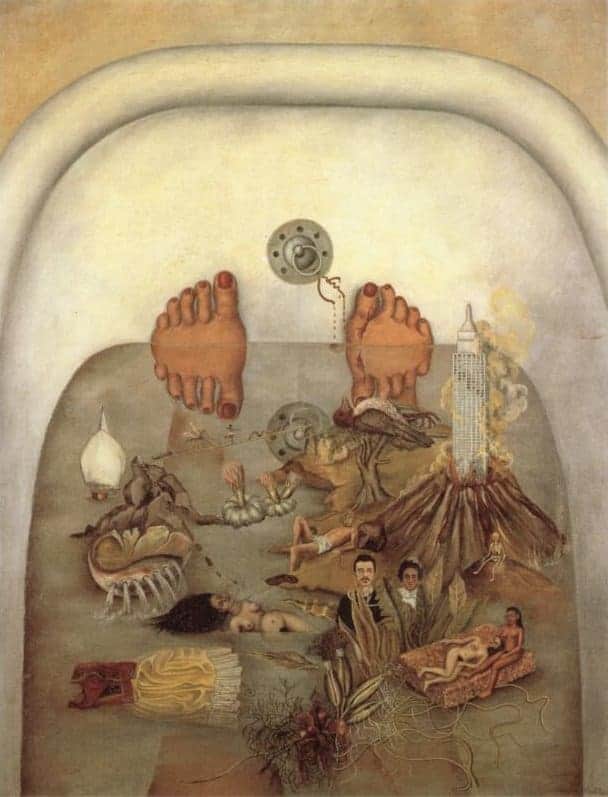
19.Without Hope By Frida Kahlo
“Without Hope” (“Sin Esperanza”), painted by Frida Kahlo in 1945, depicts her in a hospital bed surrounded by a bleak, barren landscape.
She is shown with a grim expression and an empty, hollow gaze, symbolizing despair and the loss of hope. The painting reflects Kahlo’s physical and emotional suffering during this period, using stark imagery and muted colors to convey a profound sense of desolation and vulnerability.
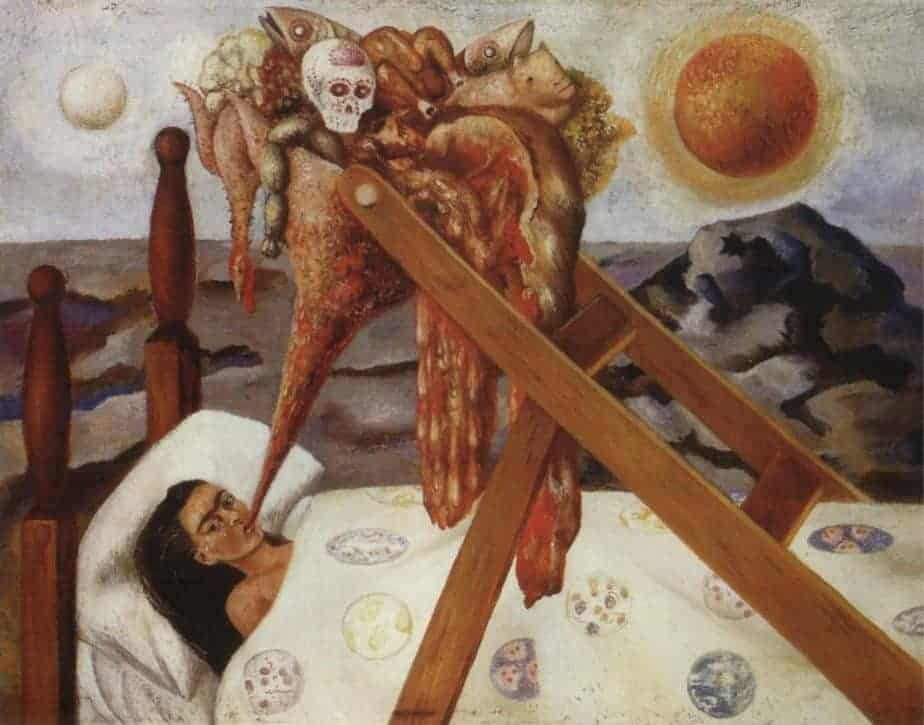
20.The Suicide Of Dorothy Hale
“Suicide of Dorothy Hale,” painted by Frida Kahlo in 1939, is a powerful and unsettling work that depicts the tragic death of Dorothy Hale, an American socialite and friend of Kahlo.
The painting is divided into three panels: the left panel shows Hale alive and standing with a somber expression, the center panel portrays her falling from a building in mid-air, and the right panel depicts her lifeless body after the fall, surrounded by a pool of blood.

The painting reflects Kahlo’s exploration of themes related to death, despair, and the dramatic impact of personal tragedy.
It was created as a commissioned piece for Hale’s memorial, capturing the shocking and tragic nature of her suicide in a raw and evocative manner.
21.Self-Portrait on the Borderline Between Mexico and the United States (1932)
“Self-Portrait on the Borderline Between Mexico and the United States” (1932) by Frida Kahlo depicts her standing at the border between the two countries, symbolizing her complex feelings about her identity and the contrast between the two cultures.
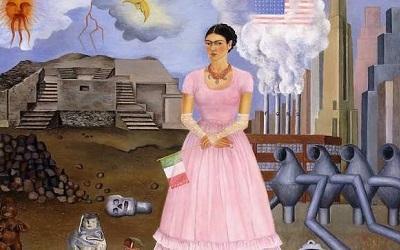
Kahlo is shown in traditional Mexican attire on one side of the border, while the other side features industrial, American elements.
The painting reflects her personal and political sentiments, highlighting the cultural and emotional divide she experienced during her time in the U.S.
Frida Kahlo (1907-1954) has often been classified as a surrealist, though she herself argue that she draws more “her reality, that her dreams”. A brilliant painter, she is most famous for her portraits in which she paints herself in a surrealistic manner. Frida Kahlo was not forgotten.
The article contains sponsored affiliate links from Amazon to valuable resources.


